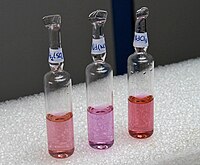User:Praseodymium-141/Neodymium compounds
Neodymium compounds are compounds formed by the lanthanide metal neodymium (Nd). In these compounds, neodymium generally exhibits the +3 oxidation state, such as NdCl3, Nd2(SO4)3 and Nd(CH3COO)3. Compounds with neodymium in the +2 oxidation state are also known, such as NdCl2 and NdI2. Some neodymium compounds have colors that vary based upon the type of lighting.[1]
-
Neodymium compounds in fluorescent tube light—from left to right, the sulfate, nitrate, and chloride
-
Neodymium compounds in compact fluorescent lamp light
-
Neodymium compounds in normal daylight
Halides
[edit]
Neodymium can form four trihalides of the form NdX3. It reacts vigorously with all the stable halogens:
- 2Nd (s) + 3F2 (g) → 2NdF3 (s) [a violet substance]
- 2Nd (s) + 3Cl2 (g) → 2NdCl3 (s) [a mauve substance]
- 2Nd (s) + 3Br2 (g) → 2NdBr3 (s) [a violet substance]
- 2Nd (s) + 3I2 (g) → 2NdI3 (s) [a green substance]
The dihalides NdCl2 and NdBr2 are dark green solids,[2] with the same crystal structure as PbCl2[2] and NdI2 is a dark purple solid. They can be obtained in the Nd-NdX3 eutectic system.[3]
Organoneodymium compounds
[edit]Organoneodymium compounds are compounds that have a neodymium–carbon bond. These compounds are similar to those of the other lanthanides, characterized by an inability to undergo π backbonding. They are thus mostly restricted to the mostly ionic cyclopentadienides (isostructural with those of lanthanum) and the σ-bonded simple alkyls and aryls, some of which may be polymeric.[4]
Applications
[edit]Neodymium(III) chloride does not have strong luminescence,[5] though it serves as a source of Nd3+ ions for various light emitting materials. The latter include Nd-YAG lasers and Nd-doped optical fiber amplifiers, which amplify light emitted by other lasers. The Nd-YAG laser emits infrared light at 1.064 micrometres and is the most popular solid-state laser (i.e. laser based on a solid medium).
Neodymium(III) acetate can be used as a substitute for uranyl acetate,[6] which is used in electron microscopy.[7]
References
[edit]- ^ Burke M.W. (1996) Lighting II: Sources. In: Image Acquisition. Springer, Dordrecht. https://doi.org/10.1007/978-94-009-0069-1_2
- ^ a b Georg Brauer (Hrsg.), unter Mitarbeit von Marianne Baudler u. a.: Handbuch der Präparativen Anorganischen Chemie. 3., umgearbeitete Auflage. Band I, Ferdinand Enke, Stuttgart 1975, ISBN 3-432-02328-6, S. 1081.
- ^ Leonard F. Druding, John D. Corbett (1959-10). "RARE EARTH METAL-METAL HALIDE SYSTEMS. THE PREPARATION OF NEODYMIUM(II) HALIDES". Journal of the American Chemical Society. 81 (20): 5512–5512. doi:10.1021/ja01529a067. ISSN 0002-7863. Retrieved 2022-07-19.
{{cite journal}}: Check date values in:|date=(help) - ^ Greenwood and Earnshaw, pp. 1248–9
- ^ Henderson, B.; Bartram, Ralph H. (2000). Crystal field engineering of solid state laser materials. Cambridge University Press. p. 211. ISBN 0-521-59349-2.
- ^ Kuipers, Jeroen; Giepmans, Ben N. G. (1 April 2020). "Neodymium as an alternative contrast for uranium in electron microscopy". Histochemistry and Cell Biology. 153 (4): 271–277. doi:10.1007/s00418-020-01846-0. ISSN 1432-119X. PMC 7160090. PMID 32008069.
- ^ "Negative Staining" University of Oxford



